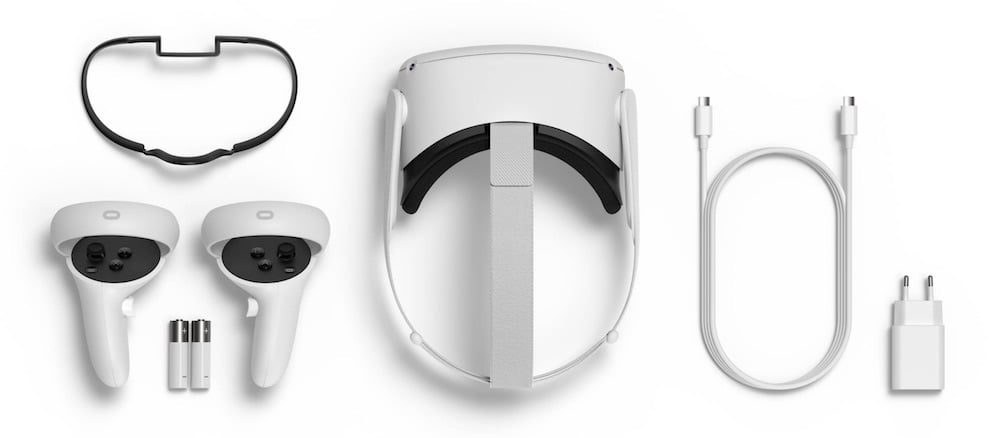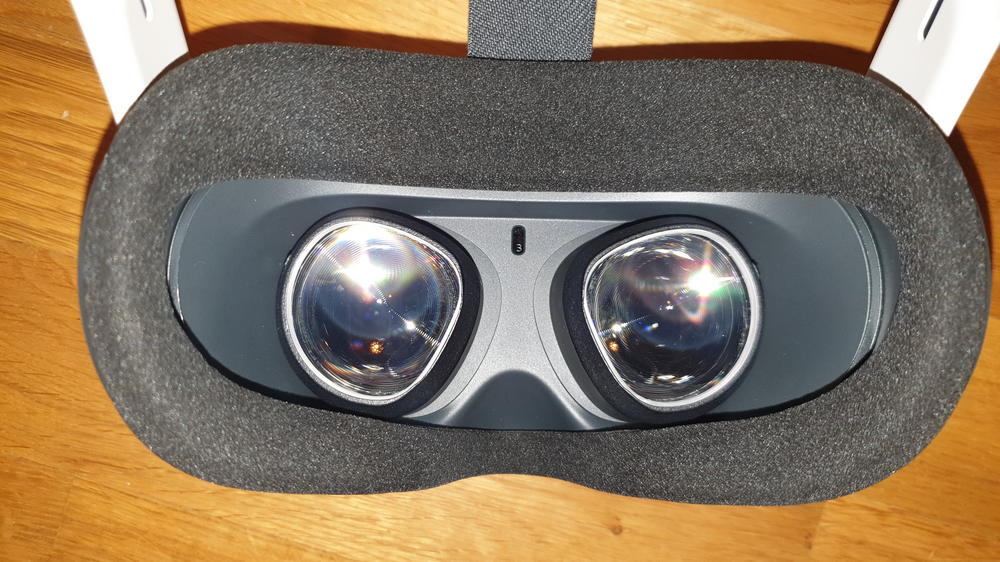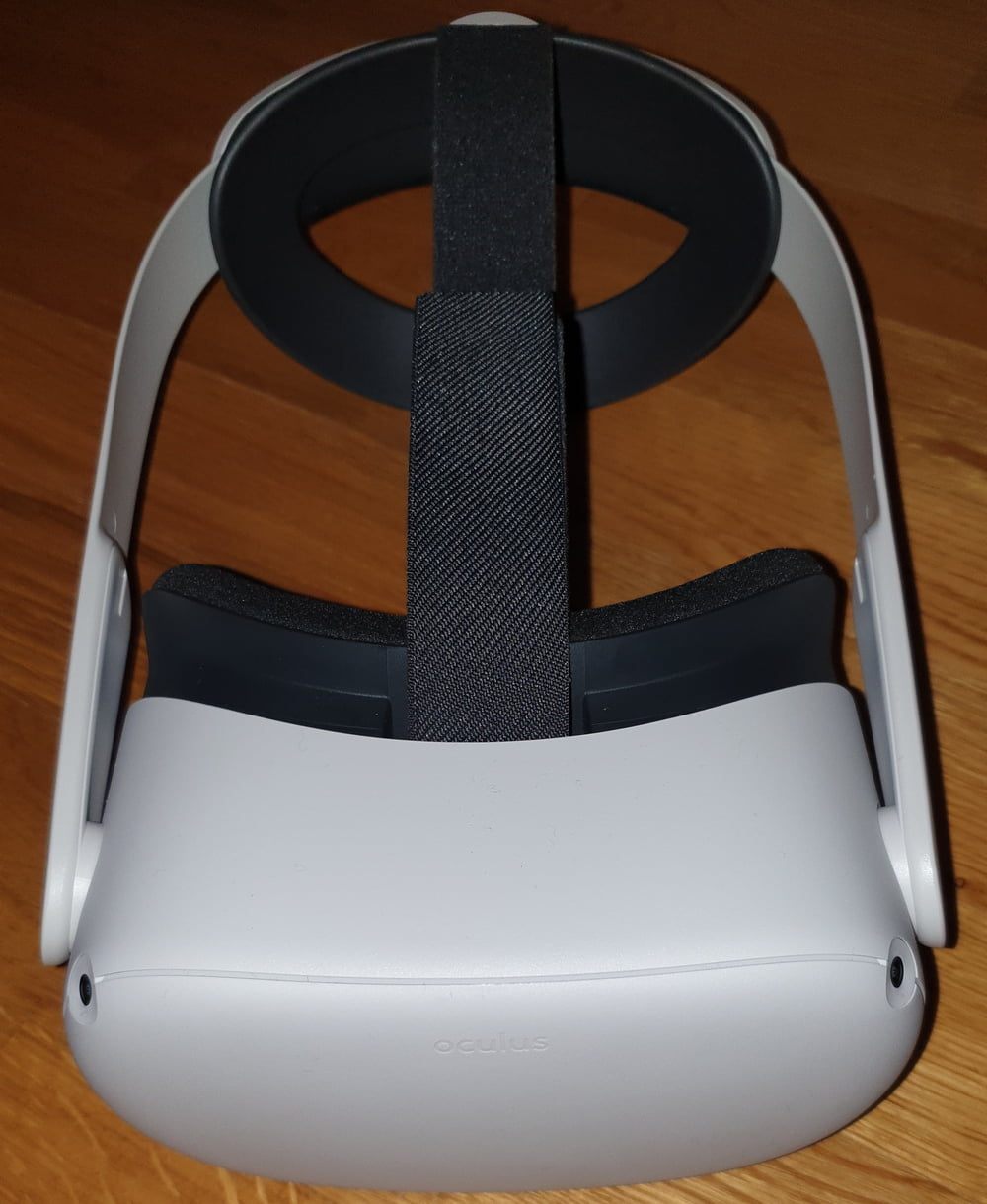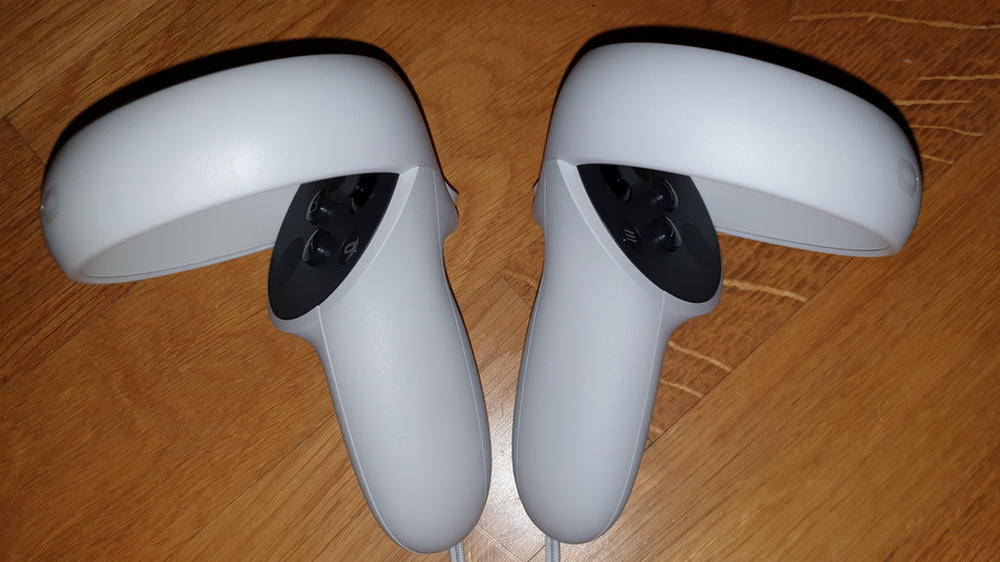Meta Quest 2 review: The VR monopoly in the Meta-Verse

In our long-term review of Meta Quest 2, the VR headset has hardly shown any weaknesses. In this review, you can learn more about how powerful Quest 2 is, and which updates have improved it further.
After the announcement in 2020 that a new VR headset from Facebook would be launched, I actually expected nothing more than a slightly improved Oculus/Meta Quest. However, according to the values (see the spec sheet) and the latest updates, the device definitely qualifies as a successor.
Quest 2 does nothing completely new. But what effect do the improvements have? What has changed in terms of comfort? And what does the requirement to have a Facebook account really mean? This review highlights advantages, but also some disadvantages of the new Facebook/Meta headset.
Content
Pairing & setup
Facebook/Meta has perfected the setup of Meta Quest 2. It takes around five minutes until Quest 2 is ready for use: After pairing it via the smartphone app and setting the Wi-Fi connection, I watch the usual tutorial video within the headset, quickly draw my playing area via the improved passthrough image and off I go!
It's hard to solve this in a better and more comfortable way.
Oculus/Meta Quest 2: Resolution, colours and frame rate
Oculus/Meta Quest 2 uses the currently best CPU for mobile devices, i.e. Qualcomm's Snapdragon XR2 processor. Installation and loading times are now noticeably shorter, and the response to inputs in the menu happens with less latency. Furthermore, a refresh rate of up to 120 Hz can be achieved with the new processor and an update, depending on the application.
The 90 Hz refresh rate is now available by default in the system environments. This includes the home environment, the Guardian system and the passthrough mode. The higher frame rate is particularly noticeable in the latter: The passthrough into reality is now much smoother and more pleasant than before.
Furthermore, 90 Hz can be used in apps that are optimized for it by the developers. Beat Saber and Superhot are already among them, for example. The picture looks smoother, which can reduce motion sickness, among other things.
The LC display can also convince in terms of clarity. The lush increase in resolution to now 1,832 x 1,920 pixels per eye makes for a very sharp picture. The screen-door effect is not gone, but I have to look much closer if I want to perceive gaps between pixels.
However, the disadvantage of the LC display is obvious. While the higher number of subpixels makes for a better picture, the black levels are mediocre. Dark areas that were really black with the OLED display of Quest 1 are now only dark gray. Those who like to play horror games in VR or watch movies with VR headsets might be disappointed.
Apart from that, the colors are rich and are conveyed very well via the sharp image. I cannot detect the so-called "mura" effect, a blotchy, unevenly bright illumination of the display. Apart from the black levels, the picture of Meta Quest 2 is really fun and does not have to hide behind native PC VR headset.
Field of view, sweet spot and interpupillary distance
The field of view is as wide as the one of Quest 1, at around 95 degrees. However, the adjuster of the interpupillary distance (IPD) can now only be changed in three positions: 58, 63 and 68 mm. With Quest 1, the interpupillary distance was still smoothly adjustable between 58 and 72 mm. The better your own interpupillary distance matches the setting of the VR headset, the higher is the picture sharpness, and the field of view has the optimal width.
To switch between the preset distances in Quest 2, I have to move the lenses manually. This is easy to do, but I have to take off the headset every time for trial and error – if I do not know my pupillary distance.

The so-called sweet spot, i.e. the middle focus area of the lenses that appears really sharp, has not changed compared to Quest 1. If the VR headset is adjusted correctly and sits neatly on the head, I have no problems with a sharp field of view – unlike, for example, the Vive Cosmos, where I have to decide between comfort or image sharpness.
For those who wear glasses, there is a spacer for self-installation. It prevents the glasses from scratching the lenses. However, on the right and left there is not much room for the spectacle frame. We recommend vision lenses from the VR optician instead. Those who already have vision lenses for their Quest 1 can use them directly for Quest 2. Those who do not have any yet: The investment is worth it.
Meta Quest 2: Wearing comfort and Elite Straps
One of the biggest criticisms of Oculus Quest 1 was the poor wearing comfort. The front-heavy VR headset starts to press heavily on the face after a short time. Long gaming sessions are a real test of endurance.

Meta Quest 2 is lighter and more compact than its predecessor headset, but remains heavy at a total of 516 grams. The included standard head strap, a simple fabric strap, does not help with wearing comfort: Quest 2 can only be attached to the head in a stable way if I accept a high contact pressure of the headset on the face. In addition, the standard strap is inconvenient to tighten: There are no Velcro fasteners on the sides, but only a loop at the back of the head. The included face pad is also quite uncomfortable – third-party manufacturers will have to step in again.
From a business point of view, the simple head mount is clever, as Meta can offer two improved head mounts separately: the Elite Strap and the Elite Battery Strap with an additional battery. Both are completely made of plastic and are attached via a rotating wheel at the back of the head. Especially the mounting for the back of the head makes for a much better and more comfortable fit. Most notably, the fit of the Elite Strap helps wear Quest properly: If the rear oval rubber part doesn't sit properly on the so-called occipital bone, I notice it right away and can readjust.
If the Elite Strap is adjusted correctly, the relief is noticeable: The pressure on the face decreases, and the headset's weight (a whopping 692 grams with the Elite Strap) shifts a bit more upwards onto the top of the skull. In addition, Quest 2 sits more comfortably and stably with the Elite Strap, without me having to tighten the dial too much. Nevertheless, the weight of the VR headset cannot be ignored, and Quest 2 also makes itself felt by pressure in the face at some point.
In plain language, this means that the Elite Strap is mandatory. Meta does not offer it as a standard head mount for marketing purposes: Quest 2 is cheaper and sells better with the simple fabric strap. However, it is then also only half as comfortable – which is not stated on the packaging.
Tracking, controller & hand tracking
Meta has not added any new tracking cameras to Quest 2. But the four cameras are supposed to behave a bit better in low light conditions. And really: I had the impression that tracking dropouts almost didn't occur at all in Beat Saber (hard mode). Overall, the tracking is excellent, as it is with Quest 1.

Speaking of controllers: The new Touch Controllers of Quest 2 are shaped a bit differently. The grip is shorter, the button pad a bit larger and it offers space to place the thumb next to the buttons without accidentally pressing anywhere. However, the shorter grip also has disadvantages: I lose my grip faster during fast movements, for example in Beat Saber, and the smooth short grips slip away. At least the batteries now last longer than in Quest 1 controllers.
Meta/Facebook has once again failed to introduce real comfort standards: There is the usual wrist strap, but a back-of-hand strap, as I can get via third-party vendors and as the controllers of the Valve Index (review) have by default, is still not officially available.
Hand tracking is integrated into the VR headset like in Quest 1, but is still only worthwhile in the menu, when operating Oculus TV or the browser, and in individual apps like Hand Physics Lab. An improvement in tracking latency or precision is now noticeable due to updates to the high-frequency tracking, which now runs at 60 Hz. However, this also leads to virtual hand tremors. Meta is still working on that.
Sound and Oculus Link
After longer tests, I have to conclude that the sound is worse and clearly less powerful than in Quest 1 – and it was already just okay then. The integrated speakers will be enough for those who do not attach too much importance to the soundscape and like to have an open ear for the surroundings. All others should connect better headphones via a 3.5 mm jack.
Oculus/Meta Link works just like with the predecessor headset and turns the standalone headset into fully functional PC VR glasses at will. By now, streaming with a 90 Hz frame rate is also possible via Oculus/Meta Link.
Quest 2 & Facebook compulsion: the product is you
Note: Meta has announced that the linking to a Facebook account will be dropped in 2022.
"If you're not paying for the product, you're not the customer. You are the product." This phrase is especially true for the corporation behind Meta Quest 2. Meta/Facebook thrives on data that we often voluntarily give away by using its services (Facebook, Instagram, WhatsApp, Oculus, and others). This data is used, among other things, for advertising that is played out to us in a personalized manner.
With the release of Oculus/Meta Quest 2, Facebook usage is no longer optional for VR enthusiasts. Quest 2 can now only be activated by tying it to a Facebook account. By buying out and massively cross-funding Oculus, and clearly subsidizing hardware that wouldn't normally be so cheap, Meta (formerly Facebook) has maneuvered itself to this point, strategically carefully planned: Meta can mandate that VR fans connect directly to the data sucker. Those who don't want that are not allowed to play – and have no equivalent alternative on the market for hybrid VR headsets (standalone and PC) and in the price range of Quest 2.
Of course, Meta claims to only require Facebook linking for the user's benefit and to offer them a better experience and networking with friends. But it is primarily about more and more personal data. For those who have always unhesitatingly handed over their data to Facebook by using the services so far, not much will change, apart from the fact that physical VR use will add another set of data that Facebook has not had access to so far.
Everyone else, however, should be aware that such a VR headset at such a premium price has another, a true price: the user's data for full, unregulated monetization and reuse.
Even though we at MIXED have a vested interest in seeing Virtual Reality thrive, we are critical of the monopoly that has been created and the Facebook account compulsion, especially since VR-interested people have no real choice: Eat or die is Meta's announcement. This power in the VR niche was simply bought by the mega corporation – and there is no company that represents serious competition at the moment.
Also highly problematic: Meta can block the Facebook account without giving reasons. Reports on reddit and Twitter tell of this. A Facebook block leads to the loss of all previously purchased games and Meta Quest 2 becomes unusable. Meta should not have this unlimited power, which is not subject to any comprehensible rules, especially since the automated account blocking system based on machine learning is hardly suitable for an irrevocable block.
The merging of user accounts of different services, which is prohibited in Germany, has led to Quest 2 not being sold in Germany so far. The fact that we are officially deprived of the best self-sufficient VR headsets (Quest 2 can easily be purchased from neighboring countries, for example via Amazon France) because Meta/Facebook does not want to limit itself in its hunger for data is just as questionable as it is necessary that such practices – i.e. the de facto blackmail of customers – are stopped.
Oculus/Meta Quest 2: Review conclusion
There is currently no better and faster way to dive into virtual reality than with Meta Quest 2. I can draw in my gaming area directly under the VR headset within minutes and see exactly where I am in reality at all times thanks to the image from the integrated cameras (passthrough). The super-sharp picture largely compensates for the poor black levels and even without the Oculus/Meta Link cable, which offers the option of PC VR, Quest 2 no longer has to hide behind PC VR headsets in terms of resolution. The Elite Strap even adds significantly more comfort, even if Meta failed to build comfortable face pads and back-of-hand straps for the controllers.
Facebook's monopoly with the currently best standalone headset even allows the company to simply add features later: 90 or 120 Hz refresh or an adaptation of the Link video stream to the new Quest resolution did not even have to be ready for prime time, and were added via an update. Meta doesn't even have to bring new apps and games – that is how sure they are that Quest 2 will be bought fairly. Which has been confirmed: Quest 2 is selling faster than any other Oculus/Meta headset before.
On top of that, Meta is not afraid of the users' unwillingness, makes a Facebook account mandatory and thus skims off a lot of (motion) data. The latter should be well thought out: Do I want to let Meta into my life more and more and give it even more data?
Apart from that, the Meta Quest 2 is currently completely unrivaled as a complete package, and – especially considering the price – technically a worthwhile investment. Even Wi-Fi streaming from the PC is now possible via Air Link. For VR fans, Quest 2 is a great VR headset, if you can and want to live with Facebook.
It would be very desirable if there were serious competition. After all, Sony has now committed to VR and announced PlayStation VR 2.
Oculus/Meta Quest 2 is for you if ...
- you want the best standalone VR headset currently available,
- want to experience a very good, clear VR picture without the hassle of cables,
- want to play PC VR games via Oculus/Meta Link if needed,
- want to put on the most comfortable Quest yet by buying the Elite Strap,
- want to buy the currently cheapest VR complete solution and
- have always given Meta/Facebook all your data anyway.
Oculus/Meta Quest 2 is not for you if ...
- you don't want to have anything to do with Facebook and don't want to participate in the account compulsion including data collection,
- you cannot stand the poor black levels (rather: gray levels),
- the short battery life still turns you off,
- you don't want to invest in additional, expensive accessories for better comfort and longer battery life, and
- are looking for new content – which is still limited.
Oculus/Meta Quest 2: Datasheet
Note: Links to online stores in articles can be so-called affiliate links. If you buy through this link, MIXED receives a commission from the provider. For you the price does not change.